Road Signs Explained: What Different Shapes and Colors Mean
Understanding the Anatomy of Road Signs
When you’re driving on the road, there are several things that you’re paying attention to. You’re watching your speed, looking out for potential hazards, making sure that you don’t miss the next turn, and so much more. You don’t exactly have the time, or mental capacity to read every single sign verbatim. Sometimes, you won’t even be able to see the details of each sign that you pass. This is why it’s so important that road signs follow design guidelines that ensure maximum visibility, recognition, and safety through the use of particular colors, shapes, and symbols.
What Different Colors, Symbols, and Shapes Mean on a Road Sign
While symbols alone are capable of conveying a lot of information very quickly, the DOT also maintains standards for the colors and shapes used to create road signs. These standards are universal so that if a driver can understand the signs in one area, they will also be able to understand them in another. For example, if a driver sees an octagonal sign with a red background and white legend it’s instantly recognizable as a stop sign.
Color is one of the key components of a sign’s anatomy. Depending on the color of a sign, drivers will be able to tell a bit about what the sign means. The 2009 Manual on Uniform Traffic Control Devices (MUTCD) for Streets and Highways sets the standards for the use of colors with road signs.
What do different color road signs mean?
- Black is used for regulatory signs
- Blue is used for interstate route, county route, evacuation route, and road user service signs
- Brown is used for forest route and recreational signs
- Coral is not yet assigned
- Fluorescent Pink is used for incident management signs
- Fluorescent Yellow-Green is used for pedestrian warning, bicycle warning, and school warning signs including playground warning, school bus, and school warning signs
- Green is used for street name, destination, reference location, and recreational information signs
- Light Blue is not yet assigned
- Orange is used for temporary traffic control and incident management signs
- Purple is used for signs that designate lanes restricted to use only by vehicles with electronic toll collection (ETC) accounts
- Red is used for prohibitive and interstate route signs
- White is used for prohibitive, permissive, state route, and U.S. route signs
- Yellow is used for different kinds of warning signs
As you can see, color is a very important aspect of the anatomy of a road sign and it can tell you a great deal about the meaning of a sign on its own. The more familiar you are with road sign colors, the easier it’ll be for you to tell the difference between signs on the road, which means you can spend less time thinking about signs and more time focusing on driving safely.
Utilizing consistent colors and familiar symbols can make it very easy to determine the meaning of a sign, but adding in the final component, the shape, makes it even easier. Each sign shape carries a different meaning, and when combined with the color and symbol, ensures that there is no confusion as to what the sign means. In many cases, only two of these aspects are necessary for a road user to know what a sign means.
What do different road sign shapes mean?
- Octagon is only used for stop signs
- Upside Down Triangle always means yield
- Circle is used to indicate that a railroad crossing is nearby
- Pennant Shape signs indicate a no passing zone
- Pentagon (pointed up) is used for school zone is ahead signs, school crossing zone signs, and country route signs
- Crossbuck (looks like an “X”) indicates a railroad crossing
- Diamond signs alert drivers to unexpected road conditions
- Rectangle (including square) signs provide regulatory notices and provide road users with directional or special information
- Trapezoid signs are used to mark cultural and recreational areas of interest and is also used for national forest route signs
Now, let’s take a look at five different road signs’ shape, color, and symbol as well as what each of them means. This is a good way to practice your knowledge of road sign anatomy.
5 Common Road Signs and What They Mean
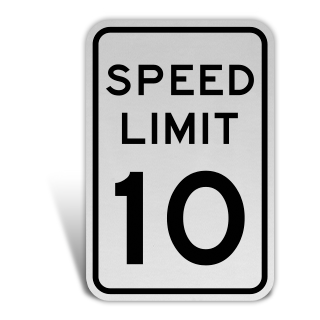
1. Speed Limit Sign – this sign is used to regulate the speed limit on a roadway. The black and white color scheme indicates that this is a regulatory traffic sign, and the rectangular shape also means that this sign provides regulatory information. The legend on this sign will indicate the maximum speed limit allowed on a particular area of the road.
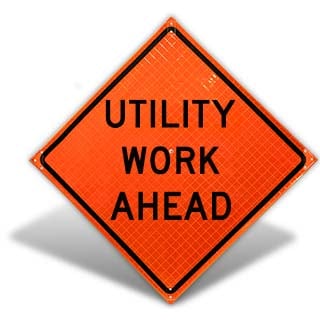
2. Utility Work Ahead Sign – this is a temporary warning sign that alerts road users to an upcoming utility work area that may alter road conditions and the flow of traffic. The color is orange, indicating that this is a temporary traffic control sign, and the diamond shape means that the sign is indicative of an unexpected road condition.
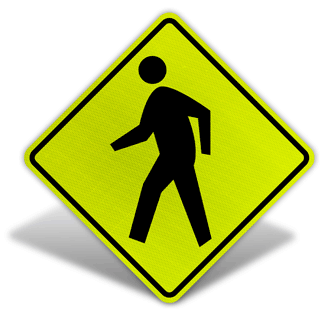
3. Pedestrian Crossing Sign – this sign is used to identify areas in which pedestrians are able to cross the road, and alerts drivers to possible road hazards caused by pedestrian traffic. The fluorescent yellow-green background indicates that this sign represents the fact that pedestrians are present, and the diamond shape alerts drivers unexpected road conditions. In this case, the unexpected condition is that a pedestrian may be crossing the roadway.
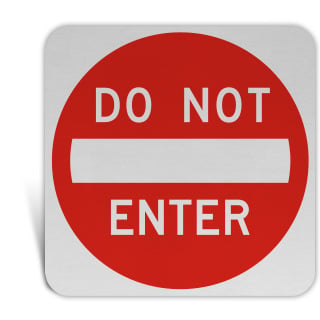
4. Do Not Enter Sign – this sign is used to indicate to road users that they can't enter a roadway from the direction that they are traveling. The white and red color scheme indicates that this is a prohibitive sign, and the square shape indicates that the sign is relevant to directional and regulatory information.
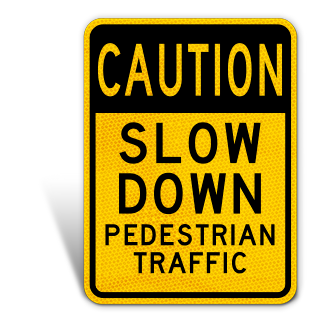
5. Caution Slow Down Sign – this sign is used to alert drivers to pedestrian traffic and indicates that they must slow down. The black and yellow color scheme reinforces this; the black indicates that this is a regulatory sign, and the yellow means that the sign is relevant to pedestrian warnings. Finally, the rectangular shape reinforces that this is a regulatory sign.
TrafficSign.com does not recommend or specify the use of a specific safety sign because it does not have knowledge of the hazard(s) our customers are identifying. It is the customer’s sole responsibility to identify the hazard(s) that may be present and select one or more signs (stock or custom) that accurately identify their specific hazard(s) and complies with any applicable federal, state or local laws or regulations, any worksite specific rules or regulations and/or any applicable safety standards (including, without limitation, MUTCD standards). TrafficSign.com disclaims any and all liability (excluding liability for our Product Warranty contained in our Terms and Conditions) for any sign selected by a customer and shall not be responsible for any personal injury or property damage resulting from the use of signs purchased from it or for the independent interpretation made of any applicable federal, state or local laws or regulations, any worksite specific rules or regulations, and/or any applicable safety standards (including, without limitation, MUTCD standards). Customer shall identify and hold TrafficSign.com and its corporate parent and its officers, directors, and affiliates harmless from and against any and all claims, loss, or expense (including attorneys’ fees) arising from or related to the purchase and use by customer or any third party of any sign purchased by customer from TrafficSign.com
